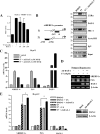Orphan nuclear receptor DAX-1 acts as a novel corepressor of liver X receptor alpha and inhibits hepatic lipogenesis
- PMID: 20080977
- PMCID: PMC2838341
- DOI: 10.1074/jbc.M109.073650
Orphan nuclear receptor DAX-1 acts as a novel corepressor of liver X receptor alpha and inhibits hepatic lipogenesis
Abstract
DAX-1 (dosage-sensitive sex reversal adrenal hypoplasia congenital critical region on X chromosome, gene 1) is a member of the nuclear receptor superfamily that can repress diverse nuclear receptors and has a key role in adreno-gonadal development. Our previous report has demonstrated that DAX-1 can inhibit hepatocyte nuclear factor 4alpha transactivity and negatively regulate gluconeogenic gene expression (Nedumaran, B., Hong, S., Xie, Y. B., Kim, Y. H., Seo, W. Y., Lee, M. W., Lee, C. H., Koo, S. H., and Choi, H. S. (2009) J. Biol. Chem. 284, 27511-27523). Here, we further expand the role of DAX-1 in hepatic energy metabolism. Transfection assays have demonstrated that DAX-1 can inhibit the transcriptional activity of nuclear receptor liver X receptor alpha (LXRalpha). Physical interaction between DAX-1 and LXRalpha was confirmed Immunofluorescent staining in mouse liver shows that LXRalpha and DAX-1 are colocalized in the nucleus. Domain mapping analysis shows that the entire region of DAX-1 is involved in the interaction with the ligand binding domain region of LXRalpha. Competition analyses demonstrate that DAX-1 competes with the coactivator SRC-1 for repressing LXRalpha transactivity. Chromatin immunoprecipitation assay showed that endogenous DAX-1 recruitment on the SREBP-1c gene promoter was decreased in the presence of LXRalpha agonist. Overexpression of DAX-1 inhibits T7-induced LXRalpha target gene expression, whereas knockdown of endogenous DAX-1 significantly increases T7-induced LXRalpha target gene expression in HepG2 cells. Finally, overexpression of DAX-1 in mouse liver decreases T7-induced LXRalpha target gene expression, liver triglyceride level, and lipid accumulation. Overall, this study suggests that DAX-1, a novel corepressor of LXRalpha, functions as a negative regulator of lipogenic enzyme gene expression in liver.
Figures






Similar articles
-
DAX-1 acts as a novel corepressor of orphan nuclear receptor HNF4alpha and negatively regulates gluconeogenic enzyme gene expression.J Biol Chem. 2009 Oct 2;284(40):27511-23. doi: 10.1074/jbc.M109.034660. Epub 2009 Aug 3. J Biol Chem. 2009. PMID: 19651776 Free PMC article.
-
MicroRNA-561 promotes acetaminophen-induced hepatotoxicity in HepG2 cells and primary human hepatocytes through downregulation of the nuclear receptor corepressor dosage-sensitive sex-reversal adrenal hypoplasia congenital critical region on the X chromosome, gene 1 (DAX-1).Drug Metab Dispos. 2014 Jan;42(1):44-61. doi: 10.1124/dmd.113.052670. Epub 2013 Oct 8. Drug Metab Dispos. 2014. PMID: 24104199
-
Tumor suppressor Menin acts as a corepressor of LXRα to inhibit hepatic lipogenesis.FEBS Lett. 2015 Oct 7;589(20 Pt B):3079-84. doi: 10.1016/j.febslet.2015.04.049. Epub 2015 May 8. FEBS Lett. 2015. PMID: 25962847
-
The gene responsible for adrenal hypoplasia congenita, DAX-1, encodes a nuclear hormone receptor that defines a new class within the superfamily.Recent Prog Horm Res. 1996;51:241-59; discussion 259-60. Recent Prog Horm Res. 1996. PMID: 8701082 Review.
-
Orphan nuclear receptors in breast cancer pathogenesis and therapeutic response.Endocr Relat Cancer. 2010 Aug 16;17(3):R213-31. doi: 10.1677/ERC-10-0058. Print 2010 Sep. Endocr Relat Cancer. 2010. PMID: 20576803 Free PMC article. Review.
Cited by
-
The nuclear receptor superfamily: A structural perspective.Protein Sci. 2018 Nov;27(11):1876-1892. doi: 10.1002/pro.3496. Protein Sci. 2018. PMID: 30109749 Free PMC article. Review.
-
Genome-wide analysis of LXRα activation reveals new transcriptional networks in human atherosclerotic foam cells.Nucleic Acids Res. 2013 Apr 1;41(6):3518-31. doi: 10.1093/nar/gkt034. Epub 2013 Feb 7. Nucleic Acids Res. 2013. PMID: 23393188 Free PMC article.
-
The roles of nuclear receptors in cholesterol metabolism and reverse cholesterol transport in nonalcoholic fatty liver disease.Hepatol Commun. 2023 Dec 15;8(1):e0343. doi: 10.1097/HC9.0000000000000343. eCollection 2024 Jan 1. Hepatol Commun. 2023. PMID: 38099854 Free PMC article. Review.
-
Inhibition of GLI Transcriptional Activity and Prostate Cancer Cell Growth and Proliferation by DAX1.Curr Issues Mol Biol. 2023 Jun 27;45(7):5347-5361. doi: 10.3390/cimb45070339. Curr Issues Mol Biol. 2023. PMID: 37504255 Free PMC article.
-
Ajuba Preferentially Binds LXRα/RXRγ Heterodimer to Enhance LXR Target Gene Expression in Liver Cells.Mol Endocrinol. 2015 Nov;29(11):1608-18. doi: 10.1210/me.2015-1046. Epub 2015 Sep 21. Mol Endocrinol. 2015. PMID: 26389695 Free PMC article.
References
-
- Giguère V. (1999) Endocr. Rev. 20, 689–725 - PubMed
-
- Aranda A., Pascual A. (2001) Physiol. Rev. 81, 1269–1304 - PubMed
-
- Iyer A. K., McCabe E. R. (2004) Mol. Genet. Metab. 83, 60–73 - PubMed
-
- Zhang H., Thomsen J. S., Johansson L., Gustafsson J. A., Treuter E. (2000) J. Biol. Chem. 275, 39855–39859 - PubMed
Publication types
MeSH terms
Substances
LinkOut - more resources
Full Text Sources
Molecular Biology Databases
Miscellaneous

